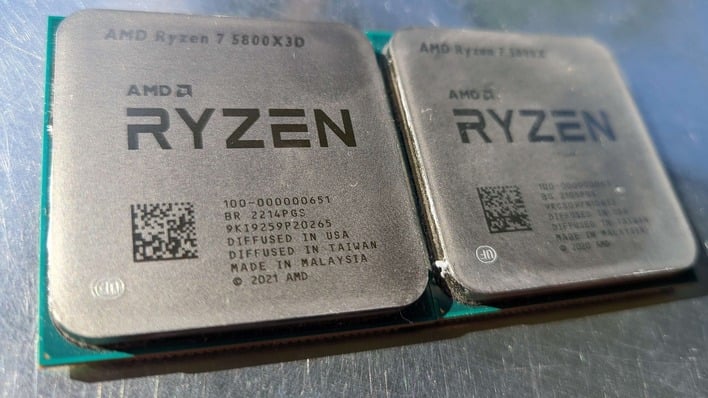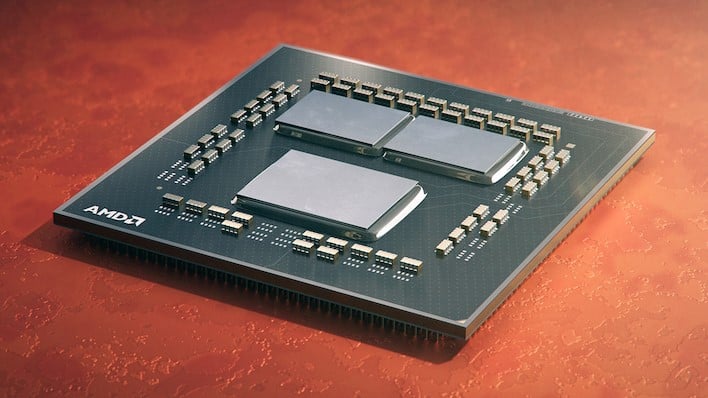Do AMD Ryzen 3D V-Cache CPUs Offer Gaming Gains For Entry-Level Graphics?
Exploring AMD 3D V-Cache's Impact On Game Performance With Mainstream GPUs

It's been nigh on nine months since Jeff Kampman from Intel's Graphics Technical Marketing team raised the question: does AMD's 3D V-Cache actually help that much if you're not running a top-end graphics card? Well, we've been busy and haven't had time until just recently to get the testing done, but now we have and can answer the question.
You see, when the Ryzen 7 5800X3D first came out, we tested it with the one of fastest graphics cards we could get our hands on. Just about every other outlet did the same thing. After all, if you want to show the biggest difference between two CPUs, you need to make sure other components aren't bottlenecking it in any way, so it only makes sense to snag the speediest graphics card around for game testing.
Most people aren't running GeForce RTX 4090 cards, though. In fact, according to the Steam survey, "most people" are running a GeForce RTX 3060, with some 6% Steam users rocking this GPU. With a lot of you likely running older Socket AM4 machines and pondering an upgrade, we thought that the time was nigh for this investigation to bear fruit, and bear fruit it has.

We've tested six games on the Ryzen 7 5800X and the Ryzen 7 5800X3D using three different entry-level graphics cards: the aforementioned GeForce RTX 3060 (in 12GB form), an Intel Arc A750 8GB card, and a Radeon RX 7600—the original recipe, not the newer "XT" model. We made sure to run each test at least three times, and sometimes as many as ten times, to ensure that we had representative results and could discard extreme outliers.
Baldur's Gate III 3D V-Cache Benchmarks


We had to test the Intel Arc A750 in DirectX 11 mode because the game is fundamentally broken in Vulkan on Arc; this is because Arc doesn't support resizable BAR functionality in Vulkan apps at this time, so its performance takes a hit. To be confident of our results, we also tested the other GPUs on DX11, but they both performed worse.
Out of the gate, we have a pretty strong performance for the 5800X3D. It has a clear advantage in both average framerates and 1% low framerates on two of our three graphics cards, and the average is significantly better even with the Radeon card. NPCs in this test are somewhat random and it's a manual test besides, so there's a measure of human variance involved, too. Regardless, 3D V-Cache is definitely beneficial in Baldur's Gate.
Final Fantasy XIV 3D V-Cache Benchmarks
Next up we have another RPG, yet a decidedly different one -- Final Fantasy XIV Online. We used the latest official Endwalker benchmark set to a resolution of 2560×1440 with the in-game settings maxed out, as that provides the most realistic use case for these graphics cards on this title.

On this game, 3D V-Cache doesn't seem to make much difference at all. None, in fact, on the Geforce RTX card, while the Arc and Radeon GPUs have inconsistent results. Let's just chalk this one up to testing variability and call it a day—3D V-Cache doesn't seem to make any difference in Final Fantasy XIV. It might be interesting to re-test this one after the forthcoming graphics update.
Fortnite 3D V-Cache Benchmarks
Normally, testing games like Fortnite is actually pretty hard because the multiplayer nature of the title ensures that no two matches are the same. However, Fortnite has a handy-dandy replay feature, and this means that we can capture the same sequence of gameplay every time. To that end, we played through a full 100-player battle royale match, found the busiest section of the replay where we got eight kills, and recorded performance data there with CapFrameX.

We have Fortnite set to DirectX 12 mode, and both the Nanite virtual geometry and hardware-accelerated Lumen ray-traced lighting options are enabled. Despite that, it still runs great on our GeForce card and fantastic on the Radeon. In all cases, we see a clear benefit for the X3D CPU, with the largest difference being on the Arc card. Unfortunately, Arc doesn't seem to handle Fortnite DX12 very well, but it runs just fine in the DX11 mode.
Cyberpunk 2077 3D V-Cache Benchmarks
After three years of patches and a paid expansion, Cyberpunk 2077 is finally something akin to the game people wanted at launch. An excellent first-person action-RPG with immense player agency and absolutely absurd graphics, the game makes for a fantastic benchmark for both CPUs and GPUs. We've set the settings probably a bit higher than they should be for this class of GPU, but they handle it surprisingly well.

Using the vendor-provided upscaling for each GPU means that the image quality results here aren't exactly equivalent, but that's not really what we're here for anyway. What we're here for is that gorgeous performance uplift from using an X3D CPU. Well, on the Arc A750 and the Radeon RX 7600, anyway; on the GeForce RTX 3060 it barely made a difference. Both of the other vendors' GPUs seem to clearly prefer the X3D processor, though. Check out the A750 hitting the highest average FPS of the three cards–Arc is good at ray-tracing.
Elden Ring 3D V-Cache Benchmarks
Elden Ring isn't the most recently-released title that we tested, but with the upcoming Shadow of the Erdtree expansion releasing in just a few months, we thought it would be interesting to examine this title and see if 3D V-Cache was a must-have CPU feature or a mainly irrelevant processor property.

Looks like it's the latter. All of the changes in our results appear to be just margin-of-error noise. If you're primarily concerned about Elden Ring performance, it doesn't look like it's worth paying the stacked-cache premium for a new CPU. Of course, FromSoftware's games have never had particularly typical performance profiles, anyway.
F1 2023 3D V-Cache Benchmarks
Finally, we wanted to get a racing game represented in our benchmarking, so we tested the latest installment in the F1 racing series. F1 2023 introduces numerous major upgrades to its renderer, and we didn't want to miss out on the glorious new global illumination, so we set the game to the "Ultra High" preset and used vendor-specific "Quality" upscaling.

Fairly inconclusive results here. The Arc card seems to clearly prefer the Ryzen 7 5800X3D, but the other two GPUs actually seem to prefer the higher clock rates of the Ryzen 7 5800X. The benchmark in this game isn't completely deterministic, so it's possible that what we're seeing is once again just benchmark noise. Either way, the differences here are pretty small; you're certainly not *missing out* by getting an X3D CPU.
Stellaris 3D V-Cache Benchmarks
Stellaris is an unusual game for us to test, because it really isn't a game where performance is generally a problem. However, specifically when testing CPUs, it can be a useful benchmark. This is because this RTS/4X hybrid performs a surprisingly rich simulation of a great number of variables that all interact in innumerable ways. We tested by loading a 100-year save game and then measuring the time it took to advance the game one year.

For this chart, remember that lower is better, as this is a measure of time. Overall, we see a clear benefit for the X3D CPU here, although the GeForce card is once again the least-affected by the CPU upgrade. It still benefits, though, and the gains for the other two GPU vendors' cards are surprisingly large. Clearly Stellaris likes the extra CPU cache.
3D V-Cache's Impact And Our Thoughts
Out of our seven games, we found about three and a half that clearly benefit from the extra L3 cache on the Ryzen 7 5800X3D. This is a bit of a contrast against our review, where all of the games we tested saw a larger benefit. What's the difference? Well, we tested different games, for one thing, but the biggest difference is that we're using a wholly different class of GPU here.
AMD's 3D V-Cache is so-called because it is literally stacked on top of the CPU.
The question we set out to answer was whether 3D V-Cache justifies its extra cost if you're not using a high-end graphics card. We think we've answered that question pretty conclusively: maybe. Some games just don't benefit from the extra cache and will prefer the higher clock rates of a CPU without 3D V-Cache. The difference there is always going to be pretty minimal, though. You're talking about a maximum of a 400 MHz difference between the Ryzen 7 5800X3D and the Ryzen 9 5950X—and the Ryzen 7 5800X is only 200 MHz faster.
Meanwhile, the difference in L3 cache is a factor of three. The Ryzen 7 5800X3D triples the L3 cache compared to the Ryzen 7 5800X. That is to say that the standard CPU has a relatively small advantage in terms of frequency, in those moments when the chip is able to boost to its highest clocks. The 3D V-Cache enabled chip, however, has a much greater advantage when it can bring its bigger cache to bear.

AMD Ryzen 7 5700X3D 8-core 3D V-Cache Gaming CPU: $247 at Amazon
AMD Ryzen 7 5800X3D 8-core 3D V-Cache Gaming CPU: $310 at Amazon
The Ryzen 7 5800X3D is currently available at Amazon for $310, but there are a couple of other options we have to note. If you're primarily gaming and you're not using a super-high-end graphics card, you can pick up a Ryzen 7 5700X3D for $50 less, currently at $247 on Amazon. That CPU loses another 100 MHz of core clock, but is otherwise identical to the Ryzen 7 5800X3D, and should give nearly identical performance, especially if you can enable PBO.
Meanwhile, if you're only gaming on the side and are primarily handling production workloads, or if your game of choice simply doesn't benefit from 3D V-Cache, we'd be remiss not to point out that the Ryzen 9 5950X, with 16 full Zen 3 CPU cores and a peak turbo clock of 4.9 GHz, is only $375 now. This was originally a $549 CPU, so it has come down quite a bit. It still offers excellent gaming and productivity performance, and makes a great upgrade for any AM4 machine.

AMD Ryzen 7 7800X3D 8-core 3D V-Cache Gaming CPU: $394 at Amazon
Of course, all of these CPUs are previous-generation hardware, and there's an argument to be made for not throwing money at an older platform. If you're already on Zen 2 or Zen 3 and are still keen for an upgrade, we might actually recommend a new system. One of the fastest gaming CPUs in the world, the Ryzen 7 7800X3D, is currently selling for $394 on Amazon—some $55 off the list price. Now might be a good time to move up to AMD's latest platform, but keep in mind that you'll need a new motherboard and RAM, of course. No such purchases are necessary for a straight Socket AM4 CPU upgrade.
To answer the other question, "should you upgrade an older Ryzen machine to X3D?," we can say "probably." If you're primarily gaming, the Ryzen 7 5800X3D still gives excellent all-around performance not far off current-generation CPUs, and the newer Ryzen 7 5700X3D will be very similar. If you're still hanging onto a machine with an old Ryzen 5 1600AF or Ryzen 7 2700X, for example, it's quite possible that a shiny new Zen 3 X3D CPU is just a BIOS upgrade away.













